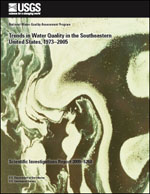As part of the U.S. Geological Survey National Water-Quality Assessment Program, water-quality data for 334 streams in eight States of the Southeastern United States were assessed for trends from 1973 to 2005. Forty-four U.S. Geological Survey sites were examined for trends in pH, specific conductance, and dissolved oxygen, and in concentrations of dissolved solids, suspended sediment, chloride, sodium, sulfate, silica, potassium, dissolved organic carbon, total nitrogen, total ammonia, total ammonia plus organic nitrogen, dissolved nitrite plus nitrate, and total phosphorus. An additional 290 sites from the U.S. Environmental Protection Agency Storage and Retrieval database were tested for trends in total nitrogen and phosphorus concentrations for the 1975-2004 and 1993-2004 periods. The seasonal Kendall test or Tobit regression was used to detect trends. Concentrations of dissolved constituents have increased in the Southeast during the last 30 years. Specific conductance increased at 62 percent and decreased at 3 percent of the sites, and pH increased at 31 percent and decreased at 11 percent of the sites. Decreasing trends in total nitrogen were detected at 49 percent of the sites, and increasing trends were detected at 10 percent of the sites. Ammonia concentrations decreased at 27 percent of the sites and increased at 6 percent of the sites. Nitrite plus nitrate concentrations increased at 29 percent of the sites and decreased at 10 percent of the sites. These results indicate that the changes in stream nitrogen concentrations generally coincided with improved municipal wastewater-treatment methods. Long-term decreasing trends in total phosphorus were detected at 56 percent of the sites, and increasing trends were detected at 8 percent of the sites. Concentrations of phosphorus have decreased over the last 35 years, which coincided with phosphate-detergent bans and improvements in wastewater treatment that were implemented beginning in 1972. Multiple regression analysis indicated a relation between changes in atmospheric inputs and agricultural practices, and changes in water quality. A long-term water-quality and landscape trends-assessment network for the Southeast is needed to assess changes in water quality over time in response to variations in population, agricultural, wastewater, and landscape variables.


